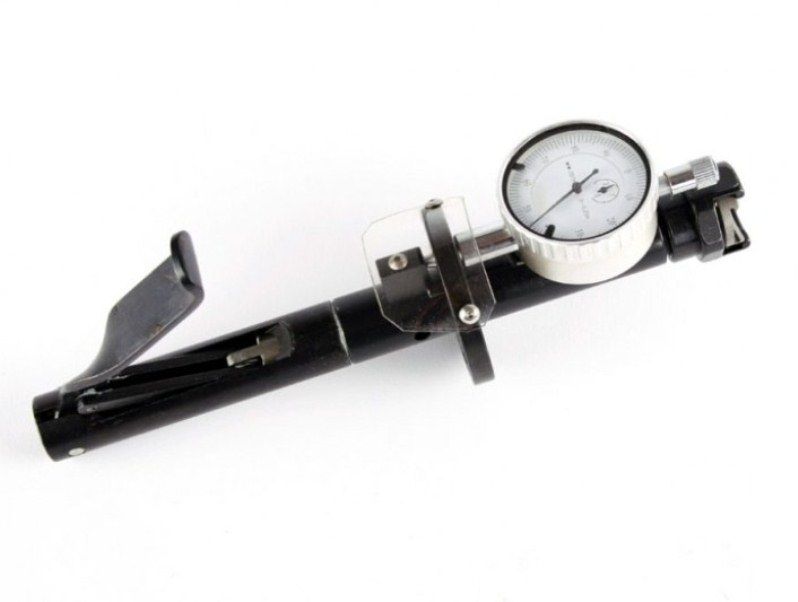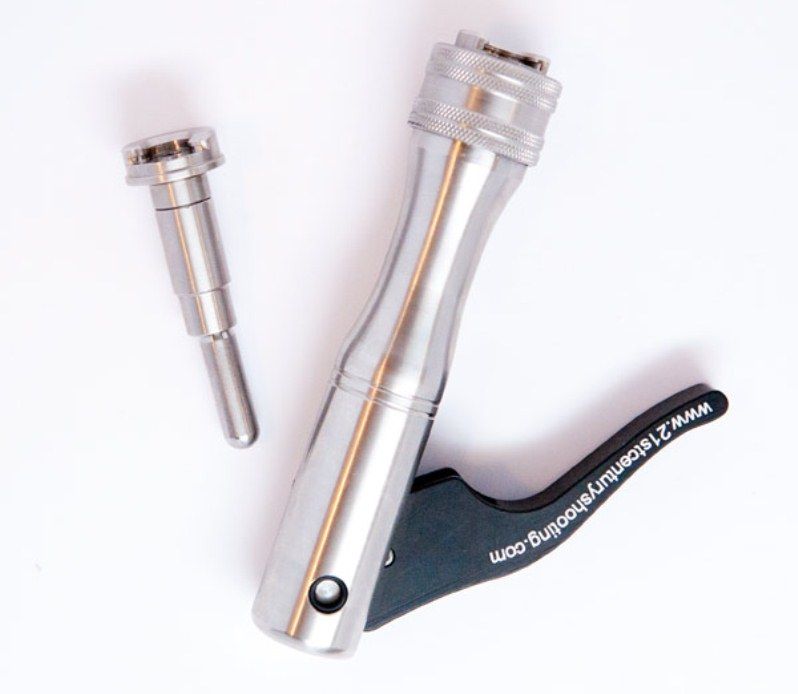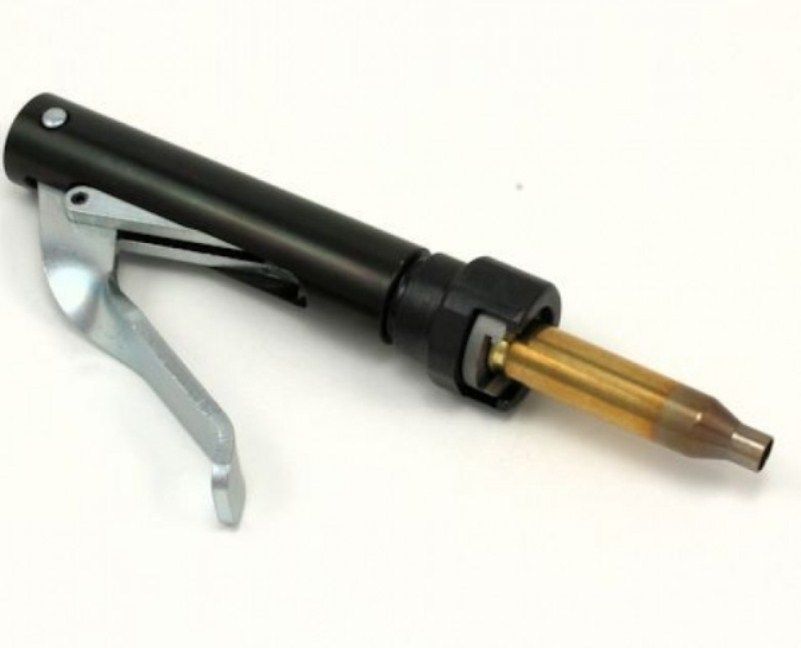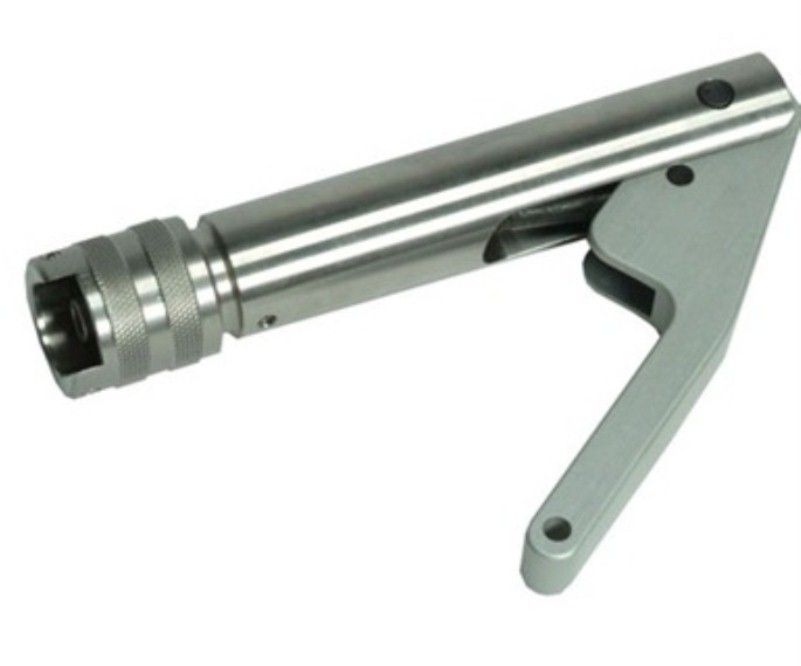|
|
Post by squawberryman on Mar 3, 2014 15:46:15 GMT -5
Question sir, given that you have no control over the construction slash firing of the primer inside the shell how/why is the path of the firing pin so critical?
|
|
|
|
Post by Lee Martin on Mar 3, 2014 16:56:40 GMT -5
The consistency in which the firing pin travels is major. When the trigger releases the shaft, vibrations begin and radiate through the action and into the barrel. As with anything on this scale, they’re miniscule. But even so you want them unchanged round to round. Fluid, unimpeded pin drop is more repeatable than drag laden movement. You’d be surprised how little it takes to throw a shot out. Consider this. At 100 yards using a 4 foot rifle, let’s say you shift the barrel 0.003”. Of course that movement can be caused by human nerves or gun harmonics. In other words, vibration. What does that equate to on paper? If the muzzle moves three-thousandths and the stock heal remains planted, that sets-up 0.003” taper across 4 feet. At 100 yards: (300 ft / 4 ft) x (0.003”) = 0.225” In benchrest, 1/5” worth of walk is significant. -Lee www.singleactions.com"Building carpal tunnel one round at a time" |
|
|
|
Post by curmudgeon on Mar 3, 2014 19:12:01 GMT -5
Very interesting, nothing dry or boring. Keep up the excellent work. It IS appreciated. Cheers
|
|
|
|
Post by squawberryman on Mar 3, 2014 19:16:32 GMT -5
Given that the pin is supposed to move concentrictly (?) down the bolt is there any lubricant? is the fit just polish against polish? Would a certain lube act as a bearing if you will to help align the pin and would that lubricant increase the lock time?
|
|
|
|
Post by curmudgeon on Mar 3, 2014 19:22:38 GMT -5
SQuawberryman, consistency and uniformity. To me not enough shooters pay enough attention to primer seating. This is why the semi-auto loaders are a big mistake to beginning handloaders. Single stage is the way to learn. Nobody takes primer seating as serious as a BR shooter.
|
|
|
|
Post by squawberryman on Mar 4, 2014 6:01:39 GMT -5
I need to learn that then.
|
|
|
|
Post by Lee Martin on Mar 4, 2014 12:31:01 GMT -5
Very good questions Squawberryman. There are a few points to discuss here so I’ll do my best to answer them. You actually don’t want the firing pin to touch anything but the primer. The assembly is supported, and in turn guided, by the cocking piece and front of the collar. All other surfaces should be gapped. Take the firing pin for example. The diameter is 0.068” and the bolt face is drilled 0.070”. That’s one-thou per side which is plenty tight. It’ll prevent primer flow but also allows free travel. Similarly, the cocking piece inlet is honed 0.2515” for the quarter-inch shaft. Lubrication of these parts is important but you don’t want grease based. Products like STP can trap grit and in close quarters cause drag. Lee- you’re spot on in terms of primer seating. Once you start using quality handhelds like the Sinclair, K&M, or S&S or you’ll never go back to the auto-primes. And as you noted, consistency and uniform pressure is a must in BR. Some guys take it to the extreme by weighing primers and seating to a prescribed depth. 0.003” below the pocket lip is common. They even make tools that’ll allow you to dial to a number. Two such devices: K&M Dial-Deluxe  21st Century Adjustable (which can be moved in 0.0025” increments)  The only problem with these is cup and anvil heights can vary. We’re talking ten-thousandths here but enough so that I haven’t bought into measured seating. The other wrinkle is anvil protrusion can differ even within the same tray. BR primers like 205M’s and CCI 4’s usually have extreme spreads of only 0.001” – 0.002”. Standard lots increase that to 0.004” – 0.008”. That’s enough variability to nix some of these tools. And everything I’ve just said assumes uniform and flushed pockets. Instead I prefer to seat by feel. How much force, or squish, should be applied? Some guys hard seat saying it ensures contact between the anvil and mixture, thus sensitizing the two. I can’t quantify that and definitely won’t suggest it improves or lessens accuracy. However, I do believe in applying the same amount of pressure and seating a few thousandths in. It doesn’t have to be four-zeros precise because the primers themselves fluctuate (cup height, cup thickness, anvil height, and anvil protrusion are the main four). I’ve been using a base K&M since the 90’s and highly recommend them. At $55 they’re a deal and you really can feel the pocket resistance as you seat.  The cheaper brands have enough play that you can’t positively tell when the cup starts to face (and more importantly when resistance starts to increase). Another model I suggest looking into is the Sinclair:  -Lee www.singleactions.com"Building carpal tunnel one round at a time" |
|
|
|
Post by seancass on Mar 4, 2014 12:50:02 GMT -5
Before Lee posted, I almost asked do you seat by pressure or measured depth, then I thought, no that's a dumb question, I don't want to sound dumb again. Ironically, I guess I was wrong. My thought was, once everything is perfect, pressure IS depth, but things like primers are never perfect.
Thanks for the great explanation Lee! Definitely info that applies outside of the BR crowd.
|
|
|
|
Post by Lee Martin on Mar 4, 2014 16:42:55 GMT -5
No such thing as a dumb question. The whole point of this thread is three-fold: 1) I wanted to expose folks to the technical side of precision shooting 2) I hoped it would evolve into discussion beyond progress shots of our action 3) Hopefully you guys can re-purpose some of these ideas and techniques for other forms of shooting ....oh, and maybe, just maybe, it would inspire one or two of you to give competitive BR a try. -Lee www.singleactions.com"Building carpal tunnel one round at a time" |
|
|
|
Post by squawberryman on Mar 4, 2014 19:35:03 GMT -5
Having owned a Sinclair and now using a 21st, that Sinclair went down the road as there is no way to control depth. I love the 21st.
|
|
|
|
Post by Lee Martin on Mar 5, 2014 10:58:25 GMT -5
I haven’t tried the 21st Century yet but hear good things about them. A friend of mine, and long-time benchrest competitor, just switched to the Deluxe dial K&M and likes it. Claims it was a little tough getting used to the adjustments but it is very well constructed. He hasn’t noticed any improvement on paper but what the hell, more controlled seating can’t hurt (previously he used a Sinclair). Going back to pin travel consistency, its importance can be illustrated through dry firing. Bench the gun and plant it as you normally would on the bags. Look through your scope, probably a 36x or higher, snap the trigger on an empty chamber, and notice the cross-hair movement. Then do the same on a dead case. It jumps more you may think. Even with a 5 – 6 pound barrel and 3” wide fore-end, pin strike creates a fair amount of vibration. There’s no way to eliminate it. Rather, the goal is to have that vibration set-up the same shot after shot. To that end, we spend a lot of time fitting the trigger and firing assembly. -Lee www.singleactions.com"Building carpal tunnel one round at a time" |
|
|
|
Post by bradshaw on Mar 5, 2014 12:39:12 GMT -5
Lee.... your notes on firing pin vibration raise questions of:
* firing pin fall.
* firing pin protrusion.
* firing pin weight.
* firing pin buffer.
Thanks,
David Bradshaw
|
|
|
|
Post by Lee Martin on Mar 5, 2014 15:06:58 GMT -5
David - we’re fitting the spring tonight so I'll show the lock-time derivation soon. That discussion will also cover primer strike. The figures you asked about: Firing pin fall = 0.250” Firing pin protrusion = 0.055” (and that’s full protrusion) Firing pin weight = 0.113 lbs (includes the pin, cocking piece, and mainspring) Firing pin buffer – see below Firing pin fall really needs to be split. There’s total firing pin travel (FPT) to full protrusion and travel to primer strike (fpt). In our case, fpt = 0.250” – 0.055” = 0.195” Mind you, these movements are small but noticeable through the scope. The cross-hairs don’t necessarily jump on target but the vibrations are seen through the reticle (everything is amplified at 36x or higher). Think about it this way. With a revolver and iron sights you can off-hand it and things look rigid. Add an optic or scope of say 6x and all the sudden you’re moving on the target. It isn’t the gun and it isn’t the optic, its nerves and muscle tension. The difference is you notice it more through glass than iron sights. But the gun moves the same amount regardless of what’s on top. And it’s no different with these bench rigs. The magnification is such that even small vibrations can be observed. Equivalent movement may not show up through a four power Bushnell. The vibrations themselves vary significantly by what they land on. Actual vibration is much higher when the pin drops on an empty chamber. In that scenario the collar stops all the movement. While we limited the bearing surface on our sleeve it’s still metal on metal. Dry firing on a primer reduces vibration because the strike is buffered. The primer’s resistance, and to a lesser degree back-pressure on the cup, slows the pin as it reaches 0.055”. The collar still impacts the bolt body but does so less abruptly. I know a lot of this seems like splitting hairs, and honestly it is. But it does translate to group size. When David Tubbs introduced his Speedlock pin assembly for Remington style bolts a lot of benchresters gave them a try. They work off of lightened shafts and heavier springs. That drops lock-time which is relevant for off-hand work. Lock-time isn't as significant in benchrest though because the gun is fixed. All other parts held constant, most found their aggs increasing with the Speedlock (across many matches and many conditions). Some of the brightest minds in the sport, to include Tony Boyer, attributed the increase to higher vibration. -Lee www.singleactions.com"Building carpal tunnel one round at a time" |
|
mod70
.240 Incinerator

Posts: 95
|
Post by mod70 on Mar 5, 2014 16:15:39 GMT -5
Lee,
You mentioned nerves and muscle tension in the grip of the revolver however you did not mention heart beat very important and must be regonized. I play around with a benchrest pistol and it is very visible with my 36X. A side note on Tubbs speedlock when I installed one on a pre 64 my off hand calls were inside took me to high 90's instead of middle. Worth the money for me. Appreciate the write up's makes me do some thinking.
John Roberts
|
|
|
|
Post by bradshaw on Mar 6, 2014 10:31:07 GMT -5
mod70.... in benchrest, the heartbeat of the wind counts more than the heartbeat of the shooter. HARD HOLDING is a High Power Rifle technique. In benchrest, one doesn't hold at all. As far as heartbeat goes, which compression counts more, left ventricle or right ventricle? Where in the cycle of which compression is trigger squeeze finalized?
Managed to catch a bit of biathlon from the Sochi Winter Olympics. Eleven or so events, of which I caught a couple. A great French male marksman and the Belarus woman who skied and shot her way to three golds. Extreme endurance exertion, followed by moments of extreme offhand marksmanship. Heart rates hit 160 beats per minute. The hyper-aerobic skiing technique is described as "skating."
I sometimes read my pulse through crosshairs. Not always. I do not see my pulse when reading iron sights, most especially on a handgun. IN BREATHING and OUT BREATHING remain my traditional technique for controlling nerves. To break the trigger during the pause between left ventricle compressions, first requires feeling the moment, second mashing the trigger before the next compression.
When I read my pulse in the DANCE of the CROSSHAIRS, I try to break between those jolts. BREATH & RYTHMN trump "psycho-tachia."
It is good to dry fire a handgun from a rest before shooting the handgun from a rest. This practice helps nestle the so-called "natural point of aim," which translates into "neutral position," or unstrained position. One assuredly may read his or her pulse through a 2x or 4x pistol scope. Sometimes, not always. As Lee Martin instructs, magnification does not manufacture reticle movement, magnification optically enlarges reticle movement.
BREATHE & SQUEEZE are the ticket to FOLLOW-THROUGH, and follow-through is the ticket to long range hits.
David Bradshaw
|
|